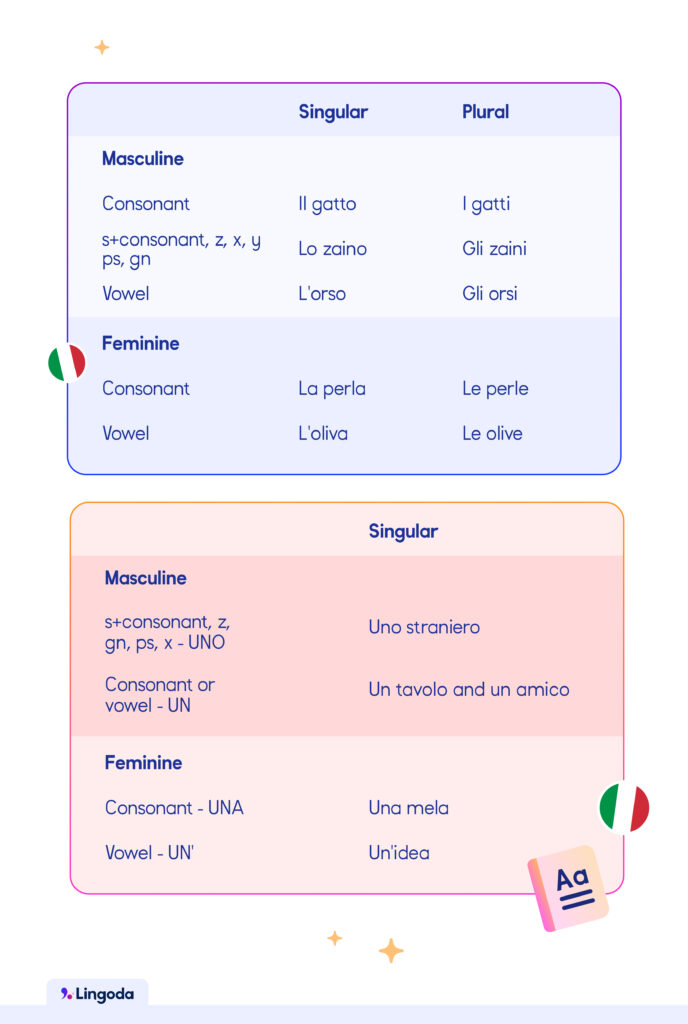Updated on March 3, 2025

Definite and indefinite articles in Italian: What they are and how to use them

Definite and indefinite articles in Italian are essential speech particles. While the former indicates that a noun is known or identifiable, the latter introduces non-specific nouns.
Italian definite articles (articoli determinativi) correspond with the English “the” and must agree in gender and number with the noun they modify. Indefinite articles (articoli indeterminativi), on the other hand, are only used in their singular form. Their English counterparts are “a” and “an”; like definite articles, indefinite articles must agree with the gender of the noun they modify.



When you learn Italian, it’s best to start with the foundational grammatical rules and their components. Italian articles, both definite and indefinite, are among these.
Articles are variable particles of the Italian language. They precede nouns and help to clarify their number, gender and level of specificity. Depending on which article you use (or not), you can describe whether a noun is identifiable, unknown or even part of a broader category.
Don’t be fooled by their size! These tiny parts of the speech hold more importance than you might think. Learning how to use them correctly won’t only help you speak and write in Italian; it will also open the door to more complicated grammatical structures involving their use (think Italian possessive pronouns, for instance). Finally, you’ll also learn how to fit them into some regional variations, expanding your understanding of Italian culture across its regions.

The Italian definite articles are il, lo, la, i, gli and le in their basic forms. These forms can, however, change in certain cases — such as when they merge with a preposition.
| Masculine | Feminine | |
| Singular | il, lo, l’ | la, l’ |
| Plural | i, gli | le |
La and le are the feminine definite articles in the singular and plural form, respectively. They’re used with the majority of feminine names.
Examples:
Il and i are the masculine definite articles in the singular and plural form, respectively. They’re used with the majority of masculine names. For example:
Lo is another masculine, singular definite article, though it appears more sparingly than il. It accompanies nouns that start with “z,” “s + consonant,” “gn,” “ps,” “x” and “pn.” For example:
The plural form of lo is gli. It follows the same rules as lo and precedes plural masculine names that start with a vowel. For example:
L’ is a contracted definite article used with singular masculine and feminine nouns. It precedes nouns that start with a vowel. For example:
Definite articles in Italian are commonly used:
You might notice some exceptions in the use of definite articles in Italian:



The Italian indefinite articles are un, uno, un’ and una. These translate to the English “a” or “an” and are only ever used in their singular form. For plural, unspecified nouns, you can use articoli partitivi (partitive articles) instead.
| Masculine | Feminine | |
| Singular | un, uno | un’, una |
| Plural | n/a* | n/a* |
Note: Generally speaking, there’s no plural form for indefinite articles. However, to express an unspecified quantity you can use partitive articles (the equivalent of “some” or “any” in English).
“Uno” is used before masculine nouns starting with z, gn, ps or s + consonant.
Una is used before feminine nouns starting with a consonant.
At first glance, you might not notice the difference between the indeterminate articles un and un’. However, the apostrophe that accompanies the second variation (un’) is what determines whether a noun is masculine or feminine.
Un (no apostrophe) is used before masculine nouns that start with a consonant or a vowel.
Un’ (with an apostrophe) is used before feminine nouns that start with a vowel.
Indefinite articles precede unspecified nouns. Since indefinite articles are only used in their singular forms, Italian relies on articoli partitivi to modify plural, uncountable nouns. These are created with a combination of the preposition di (of) and a definite article (il, lo, la, l’, i, gli, le) and they mean “some.”
They follow the same rules as the definite articles.
| Singular | Plural | ||
| di + il, lo, l’ | del, dello, dell’ | di + i, gli | dei, degli |
| di + la, l’ | della, dell’ | di + le | delle |
The choice of using an indefinite article or no article at all depends on the noun you’re modifying, its specificity as well as the context.
Indefinite articles are preferred when:
Omitting the article altogether, on the other hand, is best:
Gli is the plural form of the masculine determinate article lo. It accompanies nouns that start with z, s + consonant, gn, ps, x and pn. It also precedes plural masculine names that start with a vowel, e.g. gli occhi (the eyes) or gli zaini (the backpacks).
The main difference between Italian definite and indefinite articles revolves around the degree of specificity they give the noun they precede. Definite articles indicate specific and known nouns, and they must agree with the noun in both gender and number. Indefinite articles, on the other hand, are used with non-specific nouns and aren’t declined in their plural.
You should omit articles in Italian with singular family members whose relations are preceded by a possessive adjective, e.g. mia madre. You should also omit them before proper names of people and cities and when speaking broadly about a profession or a role.
The Italian language can be hard to learn. But definite and indefinite articles are building blocks of Italian that simply can’t be avoided, and you should start familiarizing yourself with them from your very first Italian class. Once you understand how they work and in which contexts to use them, it’ll be much easier for you to grasp more complex structures that involve their use.
Want to dive deeper? With Lingoda, you can. Our small group classes and native-level teachers give you all the support you need to practice using articles in Italian.


